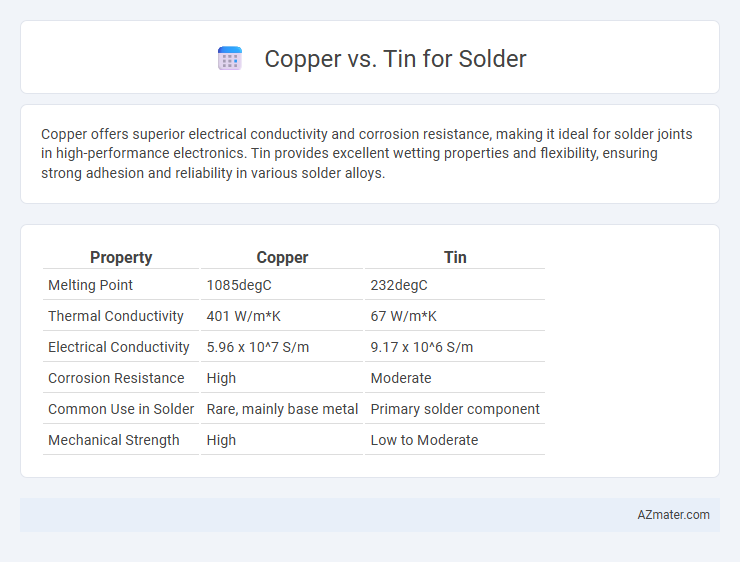Copper offers superior electrical conductivity and corrosion resistance, making it ideal for solder joints in high-performance electronics. Tin provides excellent wetting properties and flexibility, ensuring strong adhesion and reliability in various solder alloys.
Table of Comparison
| Property | Copper | Tin |
|---|---|---|
| Melting Point | 1085degC | 232degC |
| Thermal Conductivity | 401 W/m*K | 67 W/m*K |
| Electrical Conductivity | 5.96 x 10^7 S/m | 9.17 x 10^6 S/m |
| Corrosion Resistance | High | Moderate |
| Common Use in Solder | Rare, mainly base metal | Primary solder component |
| Mechanical Strength | High | Low to Moderate |
Introduction: Understanding Soldering Materials
Copper and tin are fundamental metals in soldering, each offering unique properties critical for effective joint formation. Copper provides excellent electrical conductivity and mechanical strength, making it an ideal base metal for durable solder connections. Tin, commonly alloyed with lead or silver in solder, ensures low melting points and strong adhesion to copper, optimizing the soldering process for electronic and plumbing applications.
Key Properties of Copper and Tin
Copper offers excellent electrical conductivity and superior thermal properties, making it ideal for efficient heat dissipation in solder joints. Tin provides excellent corrosion resistance and good wetting properties, enhancing the solder's ability to bond with various metals. The combination of copper's strength and tin's malleability results in durable, reliable solder connections commonly used in electronics.
Electrical Conductivity Comparison
Copper exhibits significantly higher electrical conductivity than tin, making it the preferred base metal in solder alloys for electrical applications. While pure tin has a conductivity of about 9.17 million Siemens per meter (MS/m), copper's conductivity is approximately 59.6 MS/m, nearly six times greater. This difference ensures that copper-rich solders provide better current flow and reduced electrical resistance in electronic circuits.
Melting Points and Thermal Characteristics
Copper has a melting point of 1,984degF (1,085degC), significantly higher than tin's melting point of 449.5degF (232degC), making tin more suitable for soldering applications where lower temperatures are required. Tin's excellent thermal conductivity and lower melting point allow it to melt quickly, ensuring efficient heat transfer during the soldering process without damaging sensitive components. Copper's higher melting point and superior thermal stability make it ideal for electrical connections needing durability but unsuitable as a solder due to its rigidity and difficulty melting.
Mechanical Strength and Durability
Copper exhibits superior mechanical strength and durability compared to tin when used in solder applications, providing enhanced resistance to deformation and stress over time. Tin offers excellent wettability and corrosion resistance but is softer, which can lead to decreased mechanical integrity in high-stress environments. Solder joints with higher copper content demonstrate improved longevity and reliability in electronic assemblies subjected to mechanical vibration and thermal cycling.
Oxidation and Corrosion Resistance
Copper exhibits excellent corrosion resistance and forms a stable oxide layer that protects the metal from further oxidation, making it highly durable for soldering applications. Tin, while softer and more malleable, is more prone to oxidation and forms a less protective oxide layer, leading to potential corrosion issues over time. For solder joints, copper's superior oxidation resistance ensures longer-lasting, reliable connections compared to tin.
Ease of Use in Soldering Processes
Copper offers excellent thermal conductivity, allowing solder to melt quickly and create strong, reliable joints, which simplifies the soldering process. Tin, commonly used in solder alloys, provides a lower melting point and better wetting properties, making it easier to flow and adhere during soldering. Together, tin-copper alloys balance ease of use by combining rapid heat transfer with smooth solder flow, optimizing soldering efficiency.
Common Applications: Where Copper vs Tin Excels
Copper excels in high thermal and electrical conductivity applications, making it the preferred choice for power electronics, circuit boards, and heat exchangers. Tin is favored in soldering for its excellent wettability and corrosion resistance, commonly used in electronics assembly, plumbing, and food-grade coatings. The combination of copper and tin in solder alloys balances durability and conductivity, ideal for joining electronic components with reliable mechanical strength.
Cost and Availability Analysis
Copper is generally more expensive than tin due to its higher market demand and industrial uses, impacting the overall solder cost. Tin is more abundant and widely available, often making tin-based solder alloys more cost-effective and accessible for electronic manufacturing. The fluctuation in copper prices can significantly affect production budgets, while tin's stable supply helps maintain consistent solder pricing.
Choosing the Right Material for Your Soldering Needs
Copper offers excellent thermal conductivity and durability, making it ideal for electrical connections requiring strength and heat resistance. Tin, often used in solder alloys like tin-lead or lead-free options, provides good wettability and corrosion resistance, ensuring reliable joints in electronics. Selecting the right material depends on factors such as operating temperature, mechanical stress, and environmental exposure to achieve optimal solder performance.

Infographic: Copper vs Tin for Solder
 azmater.com
azmater.com